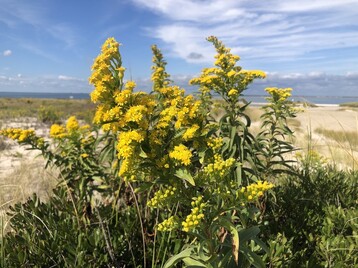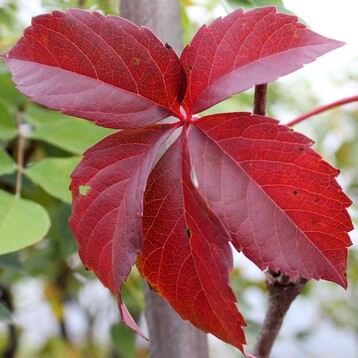Current Nature: A Bounty Of Color
Kristin Bullett, Community Engagement Coordinator at the Linda Loring Nature Foundation •

The secret is out: September is the best month to be on Nantucket. Most people will tell you this is the sweet spot of nice weather without hectic crowds- for the most part, anyway. Later this week is the first official day of fall. Time to break out maple, pumpkin and apple everything! At LLNF, we’re stoked for the astounding color that comes this time of year. New England has long been famous for stunning fall color, but Nantucket is often overlooked in this department. Fear not, we won’t miss out on the fun! Our landscapes will be changing dramatically in the coming weeks- here’s what to look for.
Late summer and early fall is peak wildflower season on island, when we see goldenrods and asters bloom. Goldenrods have small yellow flowers in dense clusters and grow well in sunny places will well-drained, dry soil. It’s no wonder we have so much Goldenrod on Nantucket! Nearly 20 different species can be found on island. They can be difficult to tell apart, but one fairly distinctive species is Seaside Goldenrod. Look for a showy plume of flowers atop waxy, thick leaves. These special leaves are an important adaptation to retain water in their salty habitats. Seaside Goldenrod grows well in sand dunes, salt marshes, beaches, and along sandy roads. Their bright pop of yellow perfectly complements a blue September sky.

The many species of asters that are found on Nantucket come in a range of blue, white, and purple tones. Asters grow well in unkempt fields, along roadsides, and in grasslands. These flowers are a late-season buffet for pollinators like bees and butterflies. Having food sources available throughout the year is important for insects. Birds like finches, chickadees, nuthatches and cardinals pick at the seed heads when the flowers die off.

It wouldn’t be fall without a splash of red. Look for Virginia creeper, a vine that turns a bright red this time of year. Virginia creeper climbs along fences, trees, signs and telephone poles. It has 5 long, thin leaves and deep blue berries. And for all the crimes against humanity that poison ivy has committed, at least it’s pretty to look at in the fall! Its shift into red also makes it much more noticeable, which is good since you can still get the infamous rash in fall. Virginia creeper and poison ivy are similar-looking, so count the leaves in each cluster to tell them apart.

Keep an eye out in the next few weeks for signs of the changing season. Our open spaces, yards, and gardens are about to give a big dramatic finale before cold temperatures roll in. Enjoy the show!
Stay tuned for more editions of Current Nature, a bi-weekly column featuring seasonal topics, natural history information, and advice on the outdoors from the staff at the Linda Loring Nature Foundation.